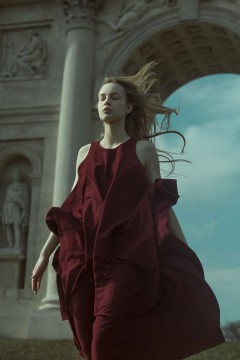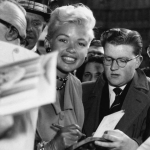Claire McCardell wearing a black dress and standing partially behind a frosted glass panel with her left hand in a side pocket. Save a black-and-white photograph of Claire McCardell wearing a black dress and standing partially behind a frosted glass panel with her left hand in a side pocket.
Claire McCardell detested discomfort. This was true long before she rose to prominence as one of America’s most well-known fashion designers in the 1950s; her face appeared on the cover of Time magazine, and her influence could be seen in every woman’s closet.
She didn’t understand why she couldn’t wear pants with pockets like her brothers because she had nowhere to put the apples she picked, and she detested wearing dresses when climbing trees as a young child growing up in Maryland. Even though she knew she would get in trouble, she decided to swim bare-legged in the lake instead of wearing the heavy full-length stockings that were required of women at summer camp because she detested wearing them.
She saw a woman shivering in a thin satin dress one evening while on a ski trip in New Hampshire in the 1930s, when she was just beginning her career as a fashion designer. McCardell questioned why a woman could not genuinely enjoy herself if an evening gown were made of a warmer material.
In her lively and psychologically astute biography Claire McCardell: The Designer Who Set Women Free, Elizabeth Evitts Dickinson describes how McCardell made a career out of asking such questions and helped revolutionize American fashion in the process.
Bosses frequently brushed off the young designer who came home from New Hampshire with a blue wool evening gown for having “crazy” ideas—wool was for coats, not parties! As was common in the American clothing industry at the time, she was instructed to continue emulating the newest styles from Paris.
McCardell lacked the influence to create clothing the way she wanted in those early years. However, she never wavered from her fundamental belief that women should feel at ease both in their clothing and in the outside world.
Dickinson writes that “we owe much of what hangs in our closets to Claire McCardell” nearly a century later, but she is not one of the fashion icons “we all remember.” How come only costume historians and fashion connoisseurs are aware of McCardell, who was once a household name?
Dickinson paints a picture of a revolutionary, albeit a pragmatic and private one, and studying McCardell’s story broadens our understanding of what revolution can entail. A cursory look at a list of McCardell’s inventions gives you a sense of how constrained and limited American women’s fashion choices used to be.
Previously, pockets were almost exclusively found on men’s clothing, but McCardell insisted on adding them to women’s clothing. (She put fasteners on the side of her clothes instead of the back so women could get dressed without a husband or maid.) McCardell knew that pockets were useful for more than just holding things; she once wrote that they could help if you were “standing in front of your boss’s desk trying to look casual and composed.”
Together with Capezio, she helped spread awareness of the ballet flat and the notion that women didn’t always need to wear heels. McCardell created separates—tops and bottoms you could mix and match—when air travel became feasible and slim suitcases took the place of steamer trunks.
She popularized the leotard, patented the wrap dress, and removed swimsuit linings to spare women from sitting in the cold and wet on the beach. Have you ever worn denim? It was McCardell who introduced it to women’s clothing, disregarding its origin as a modest workingman’s fabric.
McCardell gained early recognition and independence for these concepts, and despite passing away from colon cancer in her early 50s in 1958, she dominated American fashion for almost two decades.
She was promoted to head designer at Townley Frocks at the age of 27, and at the age of 35, she successfully negotiated her name to be listed on the label. She was allowed to express her most unconventional thoughts (one boss called them crazy so often that she started jokingly calling her favorite ideas “my crazies”). And many of them were commercial hits because they were actually pretty sensible.
She was celebrated not only as the founder of the “American Look,” but also as a judge of American tastes. By the 1950s, she was frequently asked to promote a variety of goods, such as playing cards, hair dye, and even bourbon. McCardell’s obituary appeared on the front page of the New York Times when she passed away.
As Dickinson’s well-researched account demonstrates, she was blessed with exceptional opportunities and all the comforts of life, both material and otherwise, from the time of her birth in Frederick, Maryland, in 1905. Her mother could afford frequent trips to the neighborhood general store for fabric and seasonal visits from a seamstress who allowed an inquisitive young McCardell to observe every stitch she made.
Her father was a banker, and her grandfather operated a candy company. Thankfully, her parents supported women’s education and eventually consented to pay for her time at the nearby Hood College, where she grudgingly studied home economics. In 1925, she enrolled at the New York School of Fine and Applied Art (later known as the Parsons School of Design) and left to study clothing illustration in New York and Paris.
Dickinson’s account is notable for McCardell’s early vision. She made a note: Nice clothes shouldn’t cause persistent little embarrassments after her angora sweater left lint squiggles on her high school date’s suit. Dickinson describes how she “took a seam ripper to it” as soon as she acquired a cheap dress from designer Madeleine Vionnet while studying in Paris. She disassembled the priceless item to gain a better understanding of it, then reassembled it.
Lanky and self-assured, McCardell found a job at B. Altman, displaying gowns on the storefront. She eschewed the prim and regal gait that was popular at the time in favor of a relaxed, loping slouch that made every ensemble appear effortless and alluring. What she wore was purchased by customers. (McCardell is still occasionally given credit for creating the modern walking style of models.)
McCardell disapproved of the then-common practice of stealing French designs. American merchandisers would either buy originals to copy, license designs that they were permitted to copy, or (more frequently) send young women to sketch and steal the French ideas.
The theft irritated McCardell. She sneaked out to a bench in Central Park to use her imagination when one of her first employers asked her to covertly sketch French designs at Bergdorf Goodman.
According to Dickinson, McCardell developed her persuasive abilities with the assistance of Dale Carnegie. McCardell enrolled in classes at Carnegie’s Institute of Effective Speaking after first hearing his self-improvement pitch at a meeting of the Fashion Group.
She had her first significant victory in 1938, shortly after these lessons. Whether Carnegie-inspired or not, McCardell’s first victory occurred while she was the lead designer at Townley, where she had to constantly overcome resistance from her boss, Henry Geiss. On the pocket, he battled her. He had the workroom tuck them in later after she refused to include the French fashion trend of shoulder pads.
Her most recent concept was a full-bodied gown that was wide at the hem and narrow at the shoulders. It was easy to make and cut, and it could be belted in various ways to fit women of all body types. Wearing it made a woman feel free, elegant, and effortless.
However, it appeared to be a sack on the hanger. Geiss refused to put it in the line, claiming it would never sell. Therefore, Dickinson describes how McCardell appeared in her own trapeze-style dress, cut in a rich red wool, and strode through with coffee on the day a buyer from Best & Co., a department store in New York, was in the showroom.
The Best & Co. buyer said, “You didn’t show me that one,” and immediately placed an order for 100. In a footnote, Dickinson acknowledges that the story has “several versions”; she uses her archival work and the analysis of earlier biographers to support the staged-coffee-run version of events.)
Regardless of how it was found, the dress, which became known as the “Monastic” because its loose cut recalled a monk’s robe, sold out in a day and became a national sensation. McCardell told her friends, “Geiss is so a dope.” Townley soon lost business because Geiss had been fighting copycats for a year instead of pushing McCardell to think of the next big idea.
A year later, he asked McCardell to rejoin him as he revitalized the brand with Adolph Klein as a new partner. Klein and Geiss agreed when she demanded that her name appear on the label and that she have the last say in the designs. It was 1940.
Merchandisers and manufacturers were wondering if America could dress itself after the German invasion of France and the closure of Parisian fashion. McCardell prospered due to her strategic timing and the fact that Klein, her new partner, was an expert in marketing and knew how to sell her unique designs.
Perhaps it also helped that she never had children of her own and married only after she was well established. Above all, though, she was successful because she was constantly considering how her clients would feel about their clothing. In 1947, she told a radio interviewer, “You are likely to show it when you are uncomfortable.”
Easy-to-wear clothing eliminates the need to constantly tug, pinch, and adjust it, ruining your enjoyment and making everyone else restless. Fashion historians generally concur that McCardell had a unique, creative talent for giving American women new freedom of movement. You never look really well-dressed when you’re overly conscious of what you’re wearing.
Even when Christian Dior made his debut in France with his “New Look” following World War II and started forcing women back into 18-inch-wide corsets, she refused to accept anything constricting. According to Dior, women are like flowers that should be appreciated and picked. McCardell designed with women as doers in mind.
She favored the loose arm openings that allowed a woman to “raise her arm above her head to hold a strap on the subway or hail a taxi without worrying about ripping a seam,” as Dickinson states, and frequently wore kimono or dolman sleeves.
Because of her unique and contemporary cuts, costume schools value her work, and fashion instructors continue to obsess over her methods.
It’s more difficult to say whether McCardell was truly “the designer who set women free” in a larger sense. Women undoubtedly had more fashion choices during McCardell’s lifetime, including more affordable, more revealing, more relaxed, and generally more options for how they could present themselves to the outside world.
However, McCardell was among a group of American designers who contributed to the creation of American sportswear, which is casual clothing appropriate for Americans’ busy lifestyles.
Dickinson thoughtfully acknowledges this environment by introducing us to other significant fashion pioneers, like Dorothy Shaver, the executive of Lord & Taylor, who showcased the collections of female American designers in her storefront windows long before McCardell became well-known.
Perhaps McCardell is best understood as a leading voice in a chorus of designers, all responding to the growth of mass manufacturing; to the uniquely American assumption—both democratic and consumerist—that women up and down the income scale deserved to dress well; and to the enormous opportunity presented when France went dark during the war.
The 1955 Time cover story that featured McCardell cites a list of even more forgotten peers who were pushing fashion forward as well, none of whom receive more than a passing mention in Dickinson’s account: Sydney Wragge, Clare Potter, Vera Maxwell, and Carolyn Schnurer.
The need for these new garments arose from the evolving lives of American women, and another talent would have undoubtedly seized the opportunity if McCardell had not been around.
She is still considered a revolutionary despite this, and the fashion industry periodically reexamines her because of the contemporary appeal of her geometrically innovative designs.
Tory Burch wrote the foreword to a reissue of What Shall I Wear? and debuted a collection inspired by McCardell three years ago. McCardell published (and wrote at least some of) a book in 1956 that offered fashion advice.
The true reason McCardell’s name is unknown to the general public is that, in contrast to her rival and modern-day Christian Dior, she did not name a successor or establish a plan for her line to carry on after her passing.
After appointing Yves Saint Laurent to continue his work and protect his reputation, Dior also passed away at the age of 52, a few months before McCardell.
However, it’s important to think about what a fashion legacy means: Do we recognize Dior’s name because we comprehend his work? Or have we only seen it in advertisements for bus-shelter perfume and on the side of sunglasses?
It might be more accurate to think of fashion as an industrial design rather than an art form. The man who created the potato peeler is unknown to me, but I use it at least twice a week.
During her lifetime, McCardell battled for recognition, but it seemed to be more for the freedom to do as she pleased than for the fame.
Whether we know her name or not, she might look at our contemporary closets, our wrap dresses and ballet flats, our separates and side zippers, and decide she did enough.
However, McCardell is worth mentioning as an illustration of the perseverance required in any field to see the world as it is—and to fight for the world as it ought to be.
A statue of her was erected in a local park in her hometown of Maryland in 2021. She leans back against a dressmaker’s figure in her trademark slouched pose, exuding confidence and ease.
An official statue that appears so at ease is striking; she isn’t setting the coordinates for an artillery attack or gazing off into the distance as if she were meeting the queen. Above all, she appears at ease.















